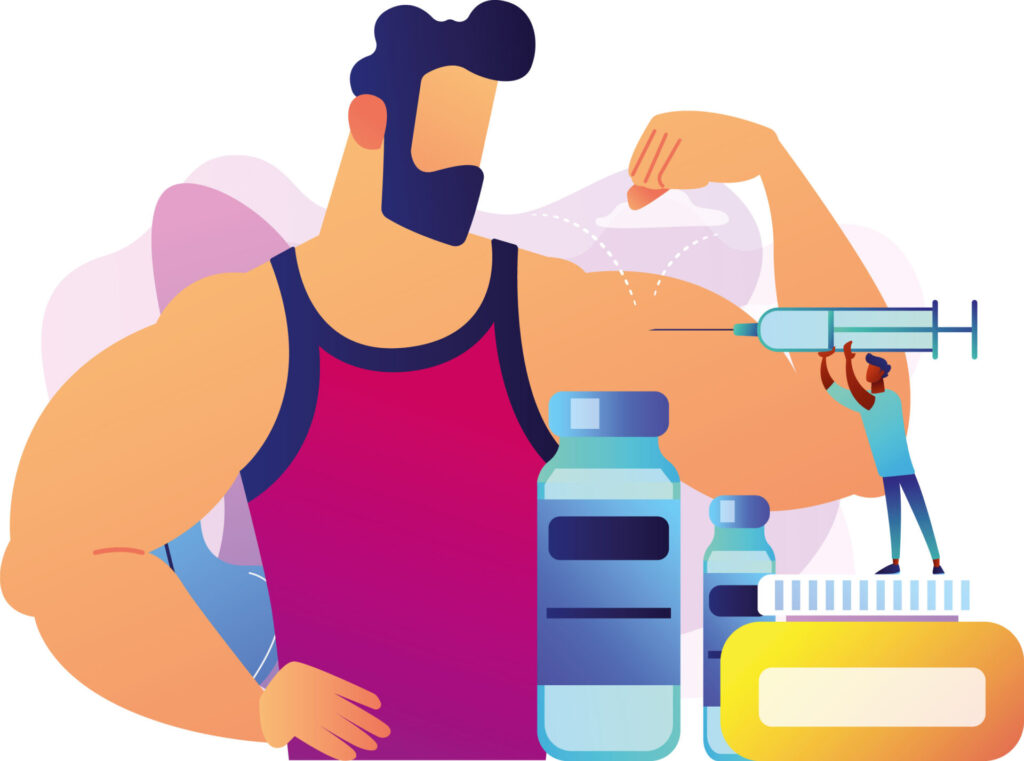Home » Supporting people who use IPEDs: A practical guide for community pharmacists

Community pharmacists are often the first point of contact for health and wellness advice. While their traditional role centres on medicines optimisation, management of common conditions, and public health, pharmacists are increasingly facing complex challenges, such as the rising use of Image and Performance Drugs (IPEDs). These substances, taken to boost physical appearance or athletic performance, are becoming a significant concern in communities across Ireland.
Although community pharmacies do not typically dispense IPEDs, their presence in the wider drug market is growing, promoted by social media, gym culture, and body image pressures, especially among young people.
They include a broad range of drugs (Table 1) and are often acquired through unregulated online platforms or illicit supply chains, where there is no oversight by regulatory authorities such as the Health Products Regulatory Agency. As a result, the products may be substandard, counterfeit, or mislabelled, with unknown excipients or inaccurate active ingredient concentrations, posing significant risks to patient safety and public health.
| Table 1: Examples of IPEDs and ancillary substances | ||
| Category | Rationale for use | Examples |
| Anabolic androgenic steroids (AAS) | Promote muscle growth, strength, and recovery by mimicking testosterone. | Testosterone, nandrolone, trenbolone |
| Selective androgen receptor modulators (SARMs) | Increase lean muscle mass and strength with fewer claims of side effects than AAS. | Ostarine, andarine |
| Recombinant human growth hormone | Stimulates growth, cell regeneration, fat loss, and lean mass gain. | Somatropin |
| Fat burners | Enhance metabolic rate and promote fat loss, often used during cutting phases. | Clenbuterol, ephedrine |
| Aromatase inhibitors and selective estrogen receptor modulator (SERMs) | Manage or prevent oestrogen-related side-effects from steroid use. Also used post-cycle to restore endogenous testosterone. | Anastrozole, letrozole, tamoxifen, clomiphene |
| Tanning agents | Used to achieve a darker skin tone. | Melanotan II |
| Diuretics | Used for rapid weight loss or muscle definition, particularly before competitions. | Furosemide, spironolactone, hydrochlorothiazide |
This article will focus specifically on AAS use, as these are the most commonly misused IPEDs. Many of the principles and practical approaches outlined will be transferable to dealing with other types of IPEDs.
Anabolic-Androgenic Steroids (AAS) are synthetic derivatives of testosterone that are commonly misused for their anabolic effects such as increased muscle mass, strength, and enhanced recovery. AAS use is rarely continuous. Instead, users tend to follow specific patterns (Table 2) to enhance effectiveness and reduce adverse effects, although evidence for these strategies is largely anecdotal and unsupported by evidence.
| Table 2: Patterns of IPED use | |
| Pattern | Description |
| Cycling | Steroids are taken for a defined period (typically six – 12 weeks), followed by an off-cycle of similar duration to allow recovery of natural testosterone production. |
| Stacking | Use of multiple steroids or combining AAS with other IPEDs such as SARMs or growth hormone to enhance effects. |
| Pyramiding | Gradual increase in steroid dose followed by tapering towards the end of a cycle. |
| Blast and cruise | A more recent trend, particularly among long-term users, is to cycle between high doses (blast) and low-doses (cruise), indefinitely. |
While AAS can rapidly increase muscle mass and performance, they also carry serious, often underestimated risks. Recognising both physical and psychological side effects and the risks of unsafe injecting can allow pharmacists to identify potential AAS use and provide tailored harm-reduction advice.
Injecting is a common route of administration for many AAS. Sharing or reusing injecting equipment introduces serious risks including blood borne viruses, localised infections and systemic infection.
These risks highlight the importance of providing sterile injecting equipment, safe disposal options, and harm reduction advice at the pharmacy level.
Over 80 community pharmacies across Ireland participate in the Pharmacy Needle Exchange Programme (PNEX), a free and confidential service providing sterile injecting equipment and safe disposal options for people who inject drugs, including those using AAS. Currently there are 20 pharmacies currently providing a service for AAS users. This service is demand-led and based on local need.
Participating pharmacies can supply standard PNEX packs which contain:
Steroid-specific packs contain supplies for 21 intramuscular injections, including:
As steroid users follow a set injection pattern (Table 2), they may require larger quantities of steroid packs at once and often return corresponding amounts for safe disposal.
Pharmacies offering PNEX display the needle exchange logo in their windows (Figure 1), while those providing steroid-specific packs also display a dedicated steroid service logo (Figure 2).
| Figure 1: Pharmacy Needle Exchange Programme window sticker Source: drugs.ie | Figure 2: Pharmacy Needle Exchange Programme supplying steroid packs window sticker Source: drugs.ie |
 |
 |
A comprehensive directory of needle exchange and harm reduction services, including addiction and drug treatment centres can be found by contacting the HSE Drugs Helpline (1800 459 459).
The following case illustrates how an everyday pharmacy interaction can reveal potential AAS use and prompt harm reduction interventions.
Shane, a fit and muscular 24-year-old man, visits the pharmacy and asks for “something for acne”. On further questioning, he describes the acne as primarily affecting his back and shoulders. He says it’s getting worse, particularly over the past few weeks, and that it is “really affecting his confidence”. He also selects a milk thistle supplement, explaining that he is “taking a few things for training” and wants to “keep the liver in good shape”.
Cases like Shane’s present valuable opportunities for opportunistic engagement and early harm reduction.
Acne on the back and shoulders: Truncal acne is a common side effect of ASS use. While not diagnostic, this presentation, particularly in a muscular young male engaged in training, warrants sensitive and respectful exploration. Acne often worsens during the active (‘on’) phase of a steroid cycle, when androgen levels are highest.
Purchase of milk thistle: Although the clinical evidence supporting milk thistle for liver protection is limited, its selection may indicate Shane’s awareness of potential hepatic risk. This can open a discussion around supplement safety and liver health.
Vague disclosure: Shane’s mention that he is “taking a few things for training” is non-specific but potentially indicative of IPED use. Neutral, open-ended questions (for example, “Some supplements can affect your skin or liver, I’m happy to discuss if you’d like any advice . . .”) can encourage further dialogue without judgement.
Engage supportively: Create a private, non-judgmental environment for discussion. Even without explicit disclosure, pharmacists can build trust by offering support and practical advice.
Manage symptoms: Recommend suitable OTC treatments for acne and advise GP referral if symptoms are severe or persistent. Acknowledge that steroid-related acne may not respond to standard options.
Promote harm reduction:
Address special considerations:
Encourage safe injection practices:
Community pharmacists play a vital role in supporting individuals who use AAS and other IPEDs. By adopting a non-judgmental, informed, and confidential approach, pharmacists can help reduce the health risks associated with these substances through harm reduction advice, early identification of side effects, and appropriate signposting to specialist services. Engaging openly with this often-over-looked population not only promotes safer practices, but also strengthens the pharmacist’s role as an accessible healthcare provider within the community.
References available on request.
The NEX steroid pack service is demand-led, based on pharmacists’ requests for steroid packs. Pharmacies interested in providing this service should contact the PNEX office by emailing tim.bingham@hse.ie or normam.harnedy@hse.ie, to arrange participation and receive additional training.
For additional information visit drugs.ie > Drugs Info > Type of Drugs > Performance and image enhancing substances > Anabolic steroids.
Dr Paul McCague

School of Pharmacy, Queen’s University Belfast
Highlighted Articles